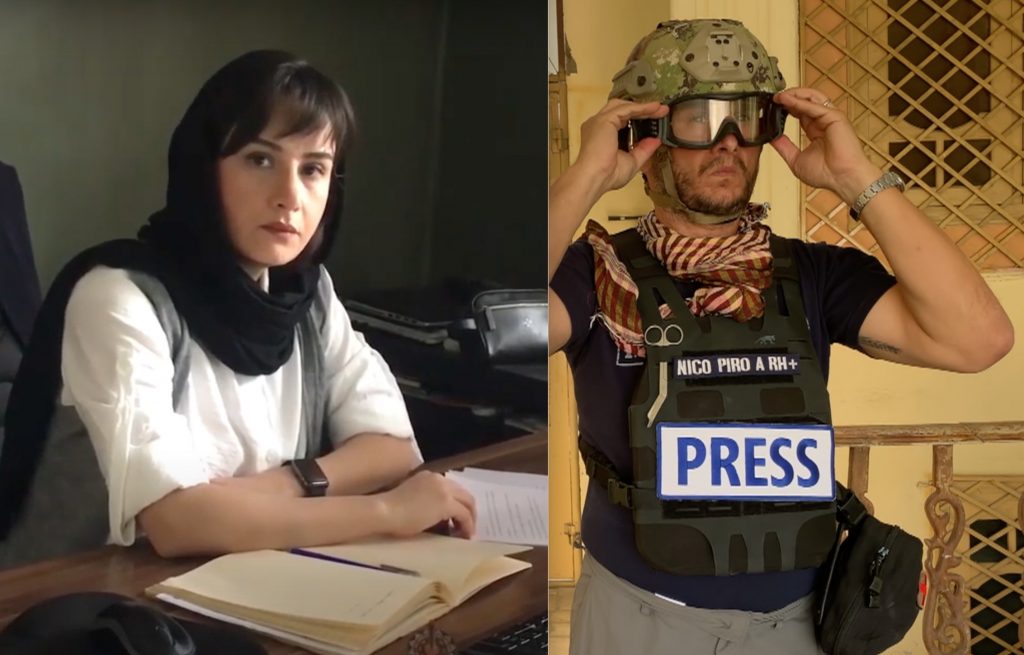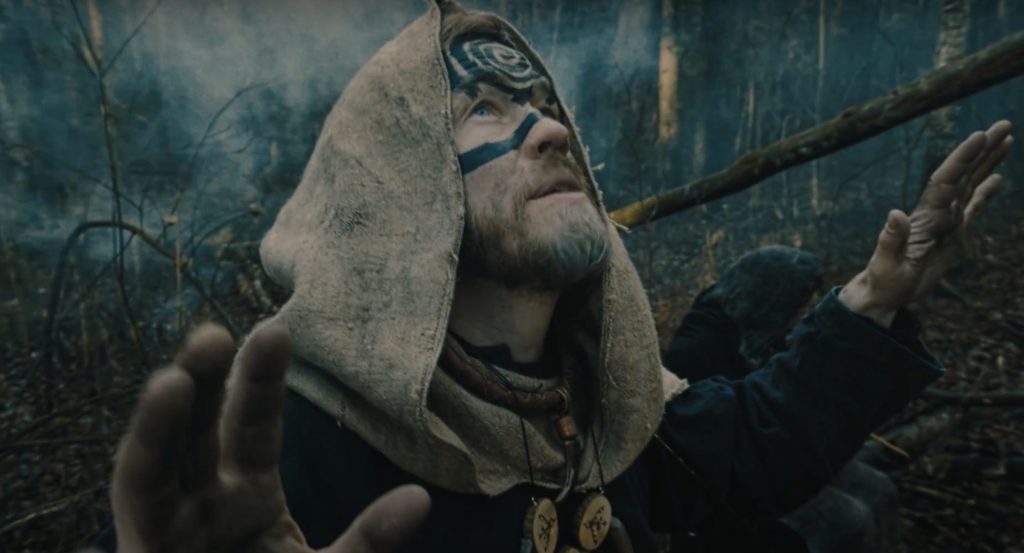The protagonist of “Invasion” recounts a visit by a mysterious entity. The film, which is visually stunning, won the Best Fiction Film Award at the Dublin Smartphone Film Festival and the Cinematography Award at Smartfone Flick Fest 2020. In the interview following the movie, Australian Peter Majarich shares the unusual journey on the way to creating this memorable sci fi drama.
Interview with Peter Majarich
MobileMovieMaking: What motivated you to become a filmmaker?
Majarich: I’m not just a filmmaker. I work as a designer and creative director in advertising by day. That entails writing, illustrating, coming up with creative concepts for brands, and occasionally…filmmaking. I first started making my own films and shooting my own stuff about five years ago. I bought a Micro Four Thirds camera and began learning about frame rates, shutter speeds, and stabilization. It was challenging, but also fun. I had an idea of what I thought looked good in a static frame, but no idea how to translate that to motion. I started making little travel films and gradually built up to making shorts. I remember one film director (I think it was Guilermo Del Toro) saying that moviemaking is the best form of art as it encapsulates everything else: music, photography, writing, acting, even typography. I really like that definition of filmmaking.
MobileMovieMaking: How did you develop your moviemaking skills: film school? books? YouTube tutorials?
Majarich: All of the above! Like most people making films, I try and soak up everything film-related that I can. I am a big fan of many filmmakers that I’ve found through my social networks or past projects. Guys like Olaf Blomerus, Diego Contreras, Josh and Jon Baker, Ash Thorp, Payman Benz, Noah Conopask, Alex Serafini — there’s so many talented folks out there that I’ve tried to emulate. A LOT of trial and error is involved, too.
MobileMovieMaking: How did you come up with the idea for “Invasion”?
Majarich: I’ve always believed that ideas should come fully formed and knock you over their head with their brilliance immediately when you conceive of them. But this project was a big lesson in the opposite of that. I shot hours and hours of footage before I had any idea what the final story was going to be. I love sci-fi, so I set myself a goal of making something in that domain. I started with a basic template of a creature feature: an alien invasion of some sort. But I wanted it to be more than that. The best science fiction isn’t about the gizmos or the technology or the aliens, but about what effect these obscure elements have on the people. In the final weeks as I was editing, and with the help of my fantastic collaborators, I was able to consolidate the final idea into what it was and what the alien creatures were there for.
MobileMovieMaking: How did you plan the shoot?
Majarich: I had rough storyboards, a voiceover script, a mood board, a treatment and all sorts of other visual reference for what I wanted to do. Usually with a project like this you would create these resources to prove to others that you know what you’re doing. But I made this for my own benefit. To prove to myself that I knew where I was going.
MobileMovieMaking: Could you tell us how you cast the movie?
Majarich: Naomi Sequeira’s profile came up on a casting website, and immediately it struck me as to how intriguing she looks. She has a great presence on screen and also helped develop the character and story.
MobileMovieMaking: What about the locations?
Majarich: The locations are all around my home suburb. There’s nothing too exotic and nothing that we had to pay for. It was all done through legwork and just working out where would look good. I’m especially proud of the car park shots. There’s an abandoned parking tower about five minutes from me that I often go and just take photos at since it looks so cool. My girlfriend — who is my number one collaborator and helps me out with every creative choice I make — is always rolling her eyes when I say we should go visit it! Because it’s not operating, there’s no artificial neon light, and if you hit it in the middle of the day, the sun washes in from the sides and just coats every surface perfectly.
MobileMovieMaking: What about the hospital shots?
Majarich: I got especially lucky here as my little son Milo was about to be born. I annoyed all the hospital staff by poking my head into empty rooms and filming them. In more ways than one, Milo was my little good luck charm!
MobileMovieMaking: The visual effects are spectacular.
Majarich: They involved a lot of trial and error. I set myself a limited budget and knew that techniques like rotoscoping were out of the question. So I ended up experimenting with biological elements as a kind of proxy for an alien entity. I deliberately decided to choose VFX elements that could work without too much interaction with the environment around them. So “floating” made sense both in terms of feasibility as well as the storyline. I’ve taught myself a tiny amount of 3D in the past few years, but for the amount of shots that were involved here, I got help with tracking and compositing them in. Naturally, the shots that started off with a nice, cinematic-looking plate with dramatic light and pleasing camera movement ended up looking the best.
MobileMovieMaking: What gear did you use?
Majarich: The film was originally created for the Moment Invitational Film Festival. SoI bought pretty much every Moment lens you can get: wide, anamorphic, telephoto, macro. I used all of them in “Invasion.” I had an ND filter on top of them most of the time. I tried adding in a pro-mist filter into the mix, but it got too heavy for the gimbal to handle. I experimented with a few different rig options. I used a DJI Osmo Mobile Gimbal with some counterweights, as well as my own cinema camera shoulder rig. For the opening push-in tracking shot, I borrowed a wheelchair from my local pharmacy for added smoothness. I’ve also done that shot multiple times before where it didn’t work out, so of course practice is key. I had some Aputure portable lights in a few shots to augment the natural light. Software wise, I used Filmic Pro to capture footage on my trusty iPhone 8. The newest smartphones are way too big for my liking. The latest models have some features like HDR filming that I might be missing out on, but even 4K/24fps on the older phones can be stunning.
MobileMovieMaking: What are the pros and cons of shooting with a phone?
Majarich: The advantages are that you can shoot almost anywhere with very little set-up time. You don’t need to have this big shoulder contraption that you usually have with a more commercial project. It’s so inconspicuous. You can just pull it out and shoot without it looking like you’re on a shoot. This changes the dynamic and the relationship your actors will have with the camera. Because I was my own DOP, I also had the luxury of being able to shoot as much as I want. The downside is that a cinema camera has built-in stability and the ability to capture shallow depth of field and higher bitrates and better color science. Both approaches have merit for sure. In the end, it’s not about the gear, it’s about the idea.
MobileMovieMaking: How long did the shoot take?
Majarich: It took months as it was spread over weekends and whenever I could get time to take my smartphone out and go shoot. I was also experimenting with three different story concepts. Two of them were abandoned as they didn’t work out.
MobileMovieMaking: Did you encounter any problems along the way?
Majarich: Like any production, there were many, many obstacles. Software not loading. Shooting at the wrong frame rate. Running out of space on my device. VFX shots not tracking. Lens filters falling off. Takes not feeling right. Edits not coming together. It’s important to remember that these are part of the journey and a natural part of the filmmaking process. What’s really cool about this is that for whatever you encounter — especially if it is a technical problem or you’re grappling with gear — someone has probably had that issue before, and YouTube is your friend.
MobileMovieMaking: The music definitely added a lot.,
Majarich: The track is from Music Bed from the very talented A. Taylor. As soon as I heard it, I knew I wanted to use it. I didn’t have the luxury or budget to score something custom to this project, so it had to be a library song that sits under the entire story as an ambient piece.
MobileMovieMaking: Could you tell us about your editing process?
Majarich: I used Final Cut Pro for editing and coloring.Technically, it was very streamlined as you’re not working with huge 50 gigabyte rush files. You’re just using relatively small smartphone files. You’re sacrificing some quality for this convenience of course.
MobileMovieMaking: So you edited on your computer?
Majarich: It’s obviously possible also to use an editing app on the phone, but I wanted the flexibility of working on the big screen of my laptop. I hate editing. It’s my least favorite part of the filmmaking process. It feels like you’ve got this giant block of marble in front of you. And all you want to do is carve a beautiful elephant out of it. But it’s going to take a million cuts to get you there. I played around with a few plugins like FilmConvert and Osiris Luts as a starting point, and then tweaked individual frames. I cannot stress enough how important it is to start with a nice-looking shot straight out of camera to make it easy on yourself in the grading stages. But that said, a good color grade can sometimes cover up a shoddy shot, if you’re lucky. As a final step, it was all up-rezzed to 4K for maximum quality on the streaming sites.
MobileMovieMaking: How do you feel about the finished movie?
Majarich: I’m extremely satisfied with it. My goal was to create something that didn’t look like it was shot on a smartphone. And I would like to think it hit that mark. I can’t wait to do something longer and with more emotional weight next time.
MobileMovieMaking: Do you have any advice for people just starting out?
Majarich: Know that cinematography is all about light. Growing up, I honestly thought that there was some secret sauce that the “proper” cinema cameras added to a shot to make even the most mundane subject matter look compelling. Of course, this isn’t true. The best, most expensive camera won’t take a nice shot if you’re not using it properly or pointing it at the right thing. On the other hand, a $500 smartphone set on 4k @ 24 frames per second shooting into the soft light of the sunset can look absolutely magical. I would also say to underexpose, as a rule. Most shots I see look too bright and glary. Incorporate shadows and silhouettes and soft, diffuse light to add a bit of intrigue to your frames.
# # #
You can follow Peter Majarich on Instagram where, in addition to film-related images he shares photos, drawings, designs and more.
# # #
The editors of MobileMovieMaking have chosen “Invasion” as the Mobile Movie of the Week.
# # #
Links to Amazon represent an affiliate relationship we have with that company. If you click one of those links and buy something, Amazon will pay MobileMovieMaking a fee, but your cost will be the same as you’d pay if you went directly to Amazon.



 Previous post
Previous post
 Next post
Next post






Fantastic, this was filmed on a phone!